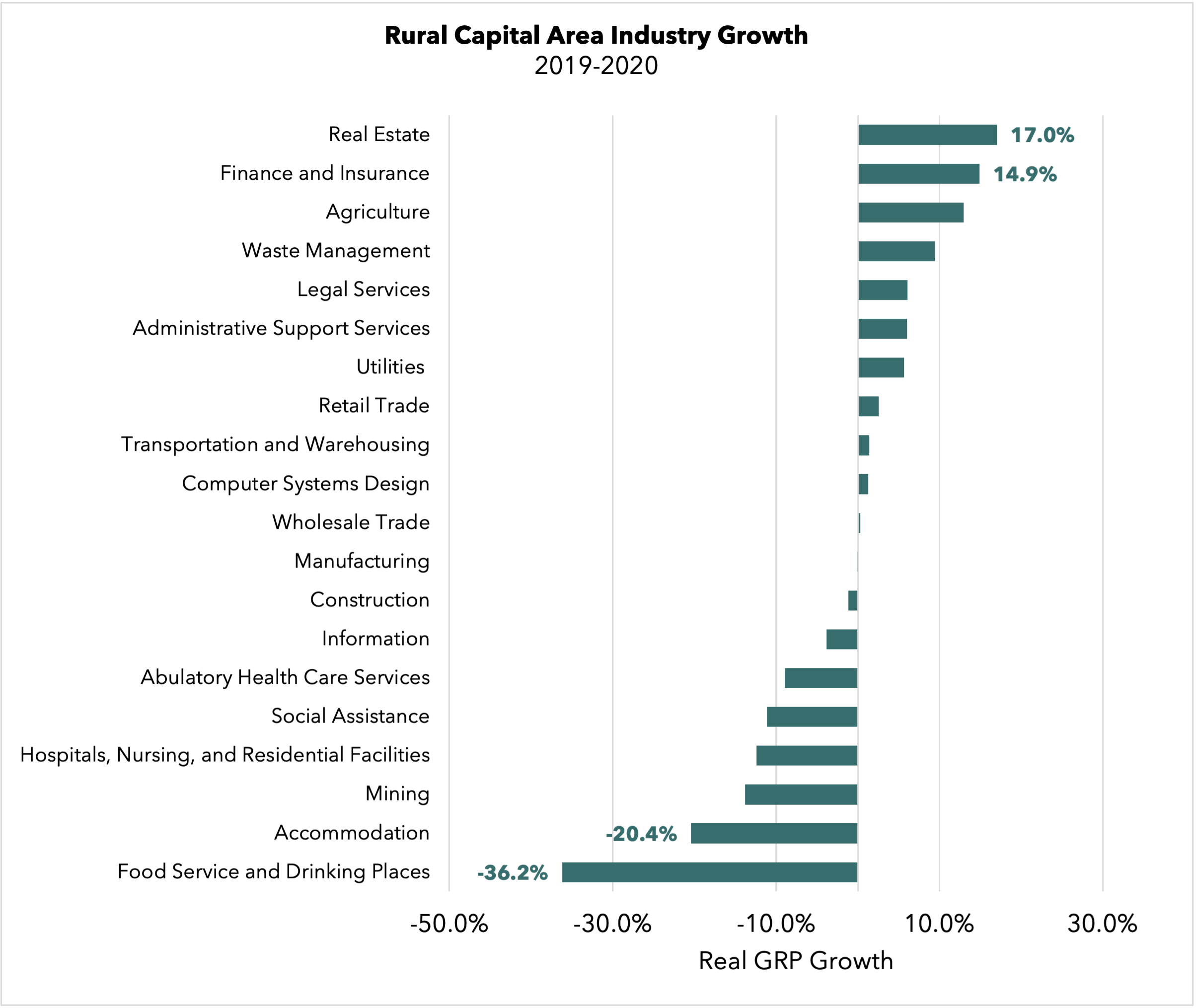Newly released data reveals which industries struggled and which succeeded in the Rural Capital Area (RCA) during the first year of the COVID-19 pandemic. While some employment data were available soon after the initial shutdowns, these mainly focused on layoffs and unemployment but did not highlight employment by industry. Analysts expected that it would take years to fully quantify the impacts of the brief, but deep, recession in the wake of COVID. This recently released data roughly two years after the events does just that. It shows what many suspected, that the pandemic created winners and losers in regional economies.
Specifically, the data analyzed here represent Gross Regional Product (GRP). GRP is the regionalized version of Gross Domestic Product (GDP), which captures all formal and value-added economic activity occurring within a country’s borders. The value of goods and services produced within a country are rolled up to create a single number representing the size of that country’s economic output. The same idea applies to GRP, which can be broken down to the county and industry level. This breakdown reveals which industries represent the largest net contributors to regional economies and how fast the economy is growing or shrinking.
From 2019 to 2020, the RCA economy grew while the broader US economy shrank. GRP in the RCA increased 1.5 percent compared to a GDP decrease of 3.4 percent across the United States. This stark difference is mainly due to the industries in the RCA that performed well during the pandemic, compensating for the large losses in the leisure and hospitality industries. While industries such as food service and drinking places (food service) and accommodation experienced decreases of over 20 percent at the regional and national level, the RCA industries of finance and insurance, and real estate (the largest in the region by employment size) took off, growing by 15 and 17 percent compared to zero or negative growth in the US overall. The chart below shows the growth rates for each industry in the RCA from 2019 to 2020.

This trend generally holds at the individual county level, with a few deviations. As anticipated, food service saw the greatest declines in six of the eight counties where data is available (some data is not available depending on the size of that industry in each county) and accommodation closely followed. Real estate was the fastest growing industry in four of nine counties, while mining, information, and agriculture also grew quickly depending on the location. The table below shows the overall growth rate for each county and the industries with the fastest growth and declines in 2020. Blanco County was the fastest growing in the region, while Lee County endured the greatest declines.
|
County |
Total Growth |
Fastest Growing Industry (Rate) |
Fastest Declining Industry (Rate) |
|
Bastrop |
2.9% |
Real Estate (13.7%) |
Food Service (-42.5%) |
|
Blanco |
4.3% |
Mining (476.8%) * |
Social Assistance (-28.3%) |
|
Burnet |
1.4% |
Real Estate (17.0%) |
Food Service (-54.9%) |
|
Caldwell |
1.3% |
Real Estate (14.9%) |
Food Service (-29.9%) |
|
Fayette |
-4.0% |
Wholesale Trade (12.3%) |
Food Service (-59.0%) |
|
Hays |
0.5% |
Agriculture (28.3%) |
Mining (-50.2%) |
|
Lee |
-14.6% |
Information (20.4%) |
Computer Design (-37.4%) |
|
Llano |
3.4% |
Mining (38.2%) |
Food Service (-27.2%) |
|
Williamson |
2.7% |
Real Estate (17.2%) |
Food Service (-36.5%) |
*In 2019, mining activities (which include mining, quarrying, and oil and gas extraction) accounted for less than one percent of total GRP in Blanco County. In 2020, they accounted for more than two percent of total activity. While this was a huge jump percentage-wise, keep in mind that Blanco County is the smallest in the region.
As the note above mentions, growth rates on their own do not give an indication of size. Blanco County grew the fastest in the region, but it is also the smallest in terms of total GRP. A single dollar goes farther percentage-wise in Blanco County than it would in a large county. Lee County, which saw total economic activity decrease by almost 15 percent, is also one of the smaller counties in the region. One dollar removed from Lee County represents a larger percentage drop than it would in Williamson or Hays County. GRP itself is also an imperfect measure, failing to capture everything that happens in an economy. For example, the economic contributions of a stay-at-home parent are not included in measures of GRP, even though this category of work undoubtedly contributes to productivity and increased across the country during 2020.
Despite its shortcomings, the data solidify the takeaway that the pandemic impacted all industries differently. Restaurants, bars, and hotels saw the greatest declines in 2020. Meanwhile, the real estate industry, and the financing and legal services associated with buying a new home, surged as people took advantage of low rates and moved outside of dense urban centers. View the Gross Regional Product Dashboard to explore more of these trends over a longer time frame for the RCA.